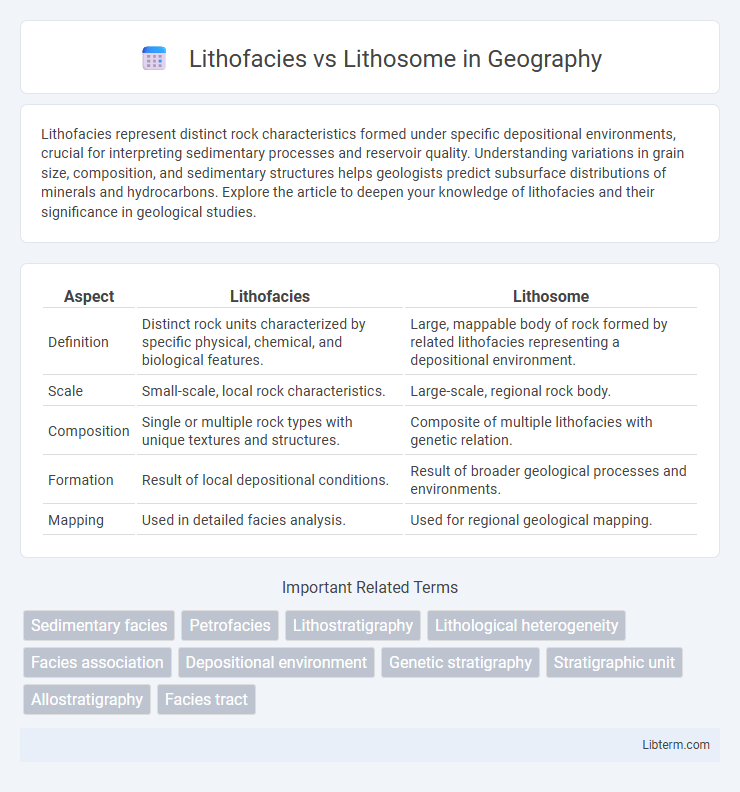Lithofacies represent distinct rock characteristics formed under specific depositional environments, crucial for interpreting sedimentary processes and reservoir quality. Understanding variations in grain size, composition, and sedimentary structures helps geologists predict subsurface distributions of minerals and hydrocarbons. Explore the article to deepen your knowledge of lithofacies and their significance in geological studies.
Table of Comparison
| Aspect | Lithofacies | Lithosome |
|---|---|---|
| Definition | Distinct rock units characterized by specific physical, chemical, and biological features. | Large, mappable body of rock formed by related lithofacies representing a depositional environment. |
| Scale | Small-scale, local rock characteristics. | Large-scale, regional rock body. |
| Composition | Single or multiple rock types with unique textures and structures. | Composite of multiple lithofacies with genetic relation. |
| Formation | Result of local depositional conditions. | Result of broader geological processes and environments. |
| Mapping | Used in detailed facies analysis. | Used for regional geological mapping. |
Introduction to Lithofacies and Lithosome
Lithofacies refers to the distinct physical and compositional characteristics of sedimentary rock layers, capturing variations in grain size, mineral content, and sedimentary structures that reflect specific depositional environments. Lithosome, on the other hand, is a larger stratigraphic unit composed of one or more lithofacies with consistent lithological properties and depositional history, representing a discrete sedimentary body. Understanding lithofacies and lithosome is crucial for interpreting sedimentary processes, reconstructing paleoenvironments, and conducting reservoir characterization in geological studies.
Definition of Lithofacies
Lithofacies refers to the distinct physical and compositional characteristics of a rock unit that reflect its depositional environment, including texture, grain size, color, and mineralogy. It represents a specific set of sedimentary features that can be used to interpret the history and conditions of sediment deposition. In contrast, a lithosome is a larger rock body composed of multiple lithofacies, representing a more extensive and heterogeneous sedimentary unit.
Definition of Lithosome
A lithosome is a volumetric unit of rock distinguished by its unique lithological properties and continuous depositional characteristics, representing a mappable body within the stratigraphic framework. Unlike lithofacies, which describe the observable physical and compositional attributes of sedimentary rocks at a particular point or thin section, lithosomes encompass spatially extensive rock bodies with consistent depositional features. The identification of lithosomes facilitates the interpretation of sedimentary environments and stratigraphic correlations in basin analysis.
Key Differences Between Lithofacies and Lithosome
Lithofacies refers to distinct rock units characterized by specific sedimentary features, textures, and composition reflecting a particular depositional environment, whereas lithosome denotes large, mappable rock bodies with uniform lithological properties formed during a single sedimentary cycle. Lithofacies analysis emphasizes micro-scale variations and environmental interpretation, while lithosome delineation focuses on macro-scale stratigraphic continuity and geological mapping. Understanding lithofacies aids in reconstructing depositional processes, whereas identifying lithosomes is crucial for regional geological correlation and resource exploration.
Role of Lithofacies in Sedimentary Geology
Lithofacies represent distinct sedimentary rock characteristics reflecting depositional environments, crucial for interpreting sedimentary processes and paleoenvironmental conditions. Their analysis aids in reconstructing sedimentary facies distribution, sediment dynamics, and basin evolution. Contrarily, lithosome denotes a larger volume of sedimentary rock bodies sharing lithofacies associations, emphasizing spatial heterogeneity and stratigraphic architecture.
Importance of Lithosome in Geological Studies
Lithosomes represent spatially extensive units of sedimentary rocks with consistent lithofacies characteristics, crucial for reconstructing depositional environments and sedimentary processes. Their importance in geological studies lies in enabling accurate correlation across stratigraphic sections, aiding in reservoir characterization and basin analysis. Lithofacies, while detailing sediment type and depositional conditions on a smaller scale, become more impactful when integrated into lithosome frameworks for comprehensive geological interpretations.
Methods for Identifying Lithofacies
Lithofacies identification relies on detailed petrographic analysis, sedimentological observations, and geochemical profiling to characterize rock textures, mineral composition, and depositional environments. Techniques such as thin section microscopy, X-ray diffraction (XRD), and scanning electron microscopy (SEM) provide critical data to distinguish lithofacies based on grain size, sorting, and sedimentary structures. Integration of core logging, well-logging tools, and outcrop studies further refines lithofacies classification by correlating subsurface and surface geological features.
Techniques for Recognizing Lithosome
Techniques for recognizing lithosome involve detailed sedimentological analysis, including grain size distribution, mineral composition, and stratigraphic continuity, which help define the three-dimensional body of rock with distinctive lithological features. Advanced methods such as petrographic microscopy, geochemical profiling, and geophysical logging enable precise differentiation of lithosome boundaries from adjacent lithofacies variations. Mapping using remote sensing and digital modeling enhances the spatial understanding of lithosome architecture, crucial for reservoir characterization and geological interpretation.
Applications in Basin Analysis
Lithofacies represent distinct rock units characterized by specific sedimentary features useful for interpreting depositional environments, while lithosomes are larger volumes of rock bodies with uniform composition and origin. In basin analysis, lithofacies analysis helps reconstruct paleoenvironments and sedimentary processes, providing detailed depositional models, whereas lithosome studies assist in understanding spatial distribution, stratigraphic architecture, and sediment supply patterns. Combining lithofacies and lithosome data enhances the characterization of sedimentary basin evolution and reservoir heterogeneity.
Summary: Lithofacies vs Lithosome
Lithofacies refers to the distinct physical, chemical, and biological characteristics of a rock unit that reflect its depositional environment and diagenetic history, while lithosome represents a larger rock body defined by a consistent lithofacies or a group of related lithofacies. Lithofacies analysis is crucial for interpreting sedimentary environments and reservoir quality, whereas lithosome mapping helps in understanding the spatial distribution and continuity of sedimentary bodies. Both concepts are essential in sedimentology and stratigraphy for reconstructing paleoenvironments and guiding exploration geology.
Lithofacies Infographic

 libterm.com
libterm.com